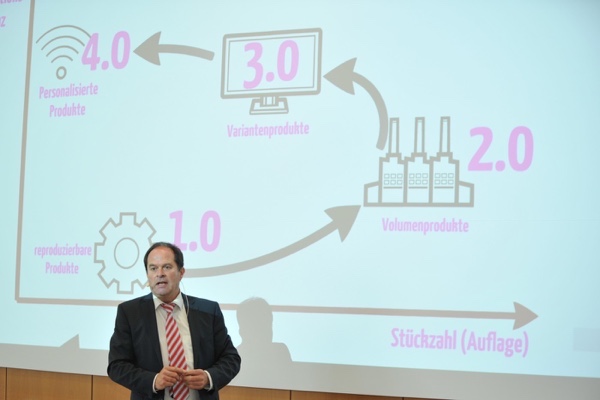Workflow
“Data means customers”

Monday 21. November 2016 - Printing Industry 4.0 convention highlights prospects for sectors digital future
The Industry 4.0 megatrend has also arrived in the printing sector. “Data is the new raw material for our industry,” stressed Michael Neugart, Chairman of the Board of Heidelberger Druckmaschinen Vertrieb Deutschland GmbH, at a convention of the print and media associations (VDM) for the German states of Baden-Württemberg and Bavaria in Wiesloch. Under the banner “This is the Future! Printing Industry 4.0”, around 150 experts explored the question of how the print media industry can use the digital age to its advantage. “As yet, theres no conclusive definition of what Industry 4.0 actually means for the printing industry,” explained Alexander Lägeler, Managing Director of the VDM in Baden-Württemberg. He said that companies were still finding this out.
Bernhard Niemela, Editor-in-Chief of the Deutscher Drucker trade journal, confirmed there were, in any case, “a whole host of excellent opportunities” on offer, including for SMEs. “The opportunities in our sector may well be even better than elsewhere, because weve been working with digital data for some time and dont have to start from scratch,” he added. It will be virtually impossible for printers to do without an IT infrastructure in the future. For Professor Klaus Thaler from Stuttgart Media University, Printing 4.0 represents “nothing more and nothing less than a paradigm shift, breaking the old rules and defining completely new ones.”
The speakers agreed that digitization means far more than printing digitally or automating print processes. “Its no longer sufficient to say we can print well,” said Thaler. He stressed that market players need to provide services “extending far beyond printing technology” and said that personalized print products were a good start. Torben Schanz from Star Corporation, a media logistics service provider in Stuttgart, underlined the importance of using web portals in the data interface to customers. “As simple printers and suppliers, were replaceable, but not if we control the interface to the customer,” he pointed out.
Steffen Setzer from Berlin-based online print shop Laserline went one step further. “We need to network all customer-related processes, especially when it comes to service,” he said, adding that intelligent use of data already makes it possible to take significant steps in the right direction. “Data means customers,” stressed Setzer. According to him, there is actually no longer any need for conventional web shops. “Why shouldnt it be possible for a secretary to simply order more letterheads at the touch of a button?” he asked, looking ahead to the digital future of customer relations.
Heidelberger Druckmaschinen AG already offers a range of components for automated printing and interface management – collecting, analyzing, and utilizing data – at what it calls a smart print shop. With the new Push to Stop operating philosophy, the software-controlled printing process runs largely autonomously. The printer only intervenes in the process if absolutely necessary. Another approach is to use several thousand sensors integrated into the press to predict expected faults and errors in the printing process and eliminate them before they actually occur. Heidelberg also boasts comprehensive IT expertise for interface management between print service providers and their customers. “We are the driving force behind digitization in our industry. The digitized value chain will be indispensable for most printing companies simply to remain competitive and fit for the future,” said Neugart.
